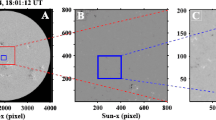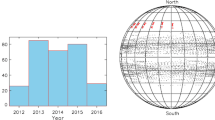Abstract
Small-scale magnetic fields can be observed on the Sun in high-resolution G-band filtergrams as magnetic bright points (MBPs). We study Hinode/Solar Optical Telescope (SOT) longitude and latitude scans of the quiet solar surface taken in the G-band in order to characterise the centre-to-limb dependence of MBP properties (size and intensity). We find that the MBP’s sizes increase and their intensities decrease from the solar centre towards the limb. The size distribution can be fitted using a log–normal function. The natural logarithm of the mean (μ parameter) of this function follows a second-order polynomial and the generalised standard deviation (σ parameter) follows a fourth-order polynomial or equally well (within statistical errors) a sine function. The brightness decrease of the features is smaller than one would expect from the normal solar centre-to-limb variation; that is to say, the ratio of a MBP’s brightness to the mean intensity of the image increases towards the limb. The centre-to-limb variations of the intensities of the MBPs and the quiet-Sun field can be fitted by a second-order polynomial. The detailed physical process that results in an increase of a MBP’s brightness and size from Sun centre to the limb is not yet understood and has to be studied in more detail in the future.










Similar content being viewed by others
Notes
There is one interesting study from Carlsson et al. (2004) which deals with centre-to-limb variations on simulated G-band images.
Around the central position the step-size was about 150 arcsec (from −123 arcsec to 76 arcsec).
SSW stands for Solar Software. It is an add-on software package for the programming language IDL, specially dedicated to solar physics. The complete description of the Hinode/SOT analysis guide can be found at http://hinode.nao.ac.jp/hsc_e/analysis_e.shtml .
It is therefore implicitly assumed that MBPs are roundish features. Another possibility would be to estimate the North–South (for the East–West scan) and East–West (for the North–South scan) elongation of the features. These feature lengths are not influenced by the foreshortening effect and provide a direct measurement of the size/extension of the features. Unfortunately, this method is not applicable to MBPs due to their small size and, hence, the low number of available measurement points (about three different possibilities for a spatial sampling of 0.1 arcsec).
Keep in mind that we have not normalised the number of detected MBPs to the size of the FOV, i.e. the decrease of detected features towards the limbs per unit solar surface is even more pronounced.
Kobel et al. (2009) state that MBPs are concentrated more towards solar disc centre whereas faculae tend to appear closer to the solar limb. The details of the spatial distribution of both features and their intersection are yet to be investigated in detail.
Only small variations have been tested due to the subsequent image conditions. On larger scales there might be a measurable influence of image contrasts on the intensity/size of the detected features.
References
Abramenko, V., Yurchyshyn, V., Goode, P., Kilcik, A.: 2010, Statistical distribution of size and lifetime of bright points observed with the new solar telescope. Astrophys. J. Lett. 725, L101 – L105. doi: 10.1088/2041-8205/725/1/L101 .
Auffret, H., Muller, R.: 1991, Center-to-limb variation of the network bright points in the solar photosphere. Astron. Astrophys. 246, 264 – 279.
Berger, T.E., Title, A.M.: 2001, On the relation of G-band bright points to the photospheric magnetic field. Astrophys. J. 553, 449 – 469. doi: 10.1086/320663 .
Berger, T.E., Rouppe van der Voort, L., Löfdahl, M.: 2007, Contrast analysis of solar faculae and magnetic bright points. Astrophys. J. 661, 1272 – 1288. doi: 10.1086/517502 .
Bogdan, T.J., Gilman, P.A., Lerche, I., Howard, R.: 1988, Distribution of sunspot umbral areas – 1917 – 1982. Astrophys. J. 327, 451 – 456. doi: 10.1086/166206 .
Carlsson, M., Stein, R.F., Nordlund, Å., Scharmer, G.B.: 2004, Observational manifestations of solar magnetoconvection: center-to-limb variation. Astrophys. J. Lett. 610, L137 – L140. doi: 10.1086/423305 .
Criscuoli, S., Rast, M.P.: 2009, Photometric properties of resolved and unresolved magnetic elements. Astron. Astrophys. 495, 621 – 630. doi: 10.1051/0004-6361:200810436 .
Crockett, P.J., Mathioudakis, M., Jess, D.B., Shelyag, S., Keenan, F.P., Christian, D.J.: 2010, The area distribution of solar magnetic bright points. Astrophys. J. Lett. 722, L188 – L193. doi: 10.1088/2041-8205/722/2/L188 .
De Pontieu, B., Carlsson, M., Stein, R., Rouppe van der Voort, L., Löfdahl, M., van Noort, M., Nordlund, Å., Scharmer, G.: 2006, Rapid temporal variability of faculae: high-resolution observations and modeling. Astrophys. J. 646, 1405 – 1420. doi: 10.1086/505074 .
de Wijn, A.G., Rutten, R.J., Haverkamp, E.M.W.P., Sütterlin, P.: 2005, DOT tomography of the solar atmosphere. IV. Magnetic patches in internetwork areas. Astron. Astrophys. 441, 1183 – 1190. doi: 10.1051/0004-6361:20053373 .
Deinzer, W., Hensler, G., Schussler, M., Weisshaar, E.: 1984, Model calculations of magnetic flux tubes – part two – stationary results for solar magnetic elements. Astron. Astrophys. 139, 435 – 449.
Foukal, P., Bernasconi, P., Eaton, H., Rust, D.: 2004, Broadband measurements of facular photometric contrast using the Solar Bolometric Imager. Astrophys. J. Lett. 611, L57 – L60. doi: 10.1086/423787 .
Hathaway, D.H.: 2010, The solar cycle. Living Rev. Solar Phys. 7, 1.
Hirayama, T.: 1978, A model of solar faculae and their lifetime. Publ. Astron. Soc. Japan 30, 337 – 352.
Hirzberger, J., Wiehr, E.: 2005, Solar limb faculae. Astron. Astrophys. 438, 1059 – 1065. doi: 10.1051/0004-6361:20052789 .
Keller, C.U., Schüssler, M., Vögler, A., Zakharov, V.: 2004, On the origin of solar faculae. Astrophys. J. Lett. 607, L59 – L62. doi: 10.1086/421553 .
Kobel, P., Hirzberger, J., Solanki, S.K., Gandorfer, A., Zakharov, V.: 2009, Discriminant analysis of solar bright points and faculae. I. Classification method and center-to-limb distribution. Astron. Astrophys. 502, 303 – 314. doi: 10.1051/0004-6361/200811117 .
Kosugi, T., Matsuzaki, K., Sakao, T., Shimizu, T., Sone, Y., Tachikawa, S., Hashimoto, T., Minesugi, K., Ohnishi, A., Yamada, T., Tsuneta, S., Hara, H., Ichimoto, K., Suematsu, Y., Shimojo, M., Watanabe, T., Shimada, S., Davis, J.M., Hill, L.D., Owens, J.K., Title, A.M., Culhane, J.L., Harra, L.K., Doschek, G.A., Golub, L.: 2007, The Hinode (Solar-B) mission: an overview. Solar Phys. 243, 3 – 17. doi: 10.1007/s11207-007-9014-6 .
Langhans, K., Schmidt, W.: 2002, Center-to-limb-variation of the G-band lines at 430.5 nm. Astron. Astrophys. 382, 312 – 318. doi: 10.1051/0004-6361:20011582 .
Limpert, E., Stahel, W.A., Abbt, M.: 2008, Log-normal distributions across the sciences: keys and clues. Bioscience 51, 341 – 352. doi:10.1641/0006-3568(2001)051[0341:LNDATS]2.0.CO;2.
Muller, R.: 1975, A model of photospheric faculae deduced from white light high resolution pictures. Solar Phys. 45, 105 – 114. doi: 10.1007/BF00152221 .
Muller, R., Keil, S.L.: 1983, The characteristic size and brightness of facular points in the quiet photosphere. Solar Phys. 87, 243 – 250. doi: 10.1007/BF00224837 .
Neckel, H., Labs, D.: 1994, Solar limb darkening 1986 – 1990 (λλ 303 to 1099 nm). Solar Phys. 153, 91 – 114. doi: 10.1007/BF00712494 .
Orear, J.: 1982, Least squares when both variables have uncertainties. Am. J. Phys. 50, 912 – 916. doi: 10.1119/1.12972 .
Schüssler, M., Shelyag, S., Berdyugina, S., Vögler, A., Solanki, S.K.: 2003, Why solar magnetic flux concentrations are bright in molecular bands. Astrophys. J. Lett. 597, L173 – L176. doi: 10.1086/379869 .
Steiner, O.: 2005, Radiative properties of magnetic elements. II. Center to limb variation of the appearance of photospheric faculae. Astron. Astrophys. 430, 691 – 700. doi: 10.1051/0004-6361:20041286 .
Sütterlin, P., Wiehr, E., Stellmacher, G.: 1999, Continuum photometry of solar white-light faculae. Solar Phys. 189, 57 – 68. doi: 10.1023/A:1005243302461 .
Tsuneta, S., Ichimoto, K., Katsukawa, Y., Nagata, S., Otsubo, M., Shimizu, T., Suematsu, Y., Nakagiri, M., Noguchi, M., Tarbell, T., Title, A., Shine, R., Rosenberg, W., Hoffmann, C., Jurcevich, B., Kushner, G., Levay, M., Lites, B., Elmore, D., Matsushita, T., Kawaguchi, N., Saito, H., Mikami, I., Hill, L.D., Owens, J.K.: 2008, The Solar Optical Telescope for the Hinode mission: an overview. Solar Phys. 249, 167 – 196. doi: 10.1007/s11207-008-9174-z .
Utz, D., Hanslmeier, A., Möstl, C., Muller, R., Veronig, A., Muthsam, H.: 2009a, The size distribution of magnetic bright points derived from Hinode/SOT observations. Astron. Astrophys. 498, 289 – 293. doi: 10.1051/0004-6361/200810867 .
Utz, D., Hanslmeier, A., Muller, R., Veronig, A., Muthsam, H., Möstl, C.: 2009b, Discretization effects on the size distribution of magnetic bright points. Cent. Eur. Astrophys. Bull. 33, 29 – 38.
Utz, D., Hanslmeier, A., Muller, R., Veronig, A., Rybák, J., Muthsam, H.: 2010, Dynamics of isolated magnetic bright points derived from Hinode/SOT G-band observations. Astron. Astrophys. 511, A39. doi: 10.1051/0004-6361/200913085 .
Wiehr, E., Bovelet, B., Hirzberger, J.: 2004, Brightness and size of small-scale solar magnetic flux concentrations. Astron. Astrophys. 422, L63 – L66. doi: 10.1051/0004-6361:200400019 .
Acknowledgements
We are grateful to the Hinode team for the possibility to use their data. Hinode is a Japanese mission developed and launched by ISAS/JAXA, with NAOJ as domestic partner and NASA and STFC (UK) as international partners. It is operated by these agencies in co-operation with ESA and NSC (Norway). The research was funded by the Austrian Science Fund (FWF): J3176. D.U. and A.H. are grateful to the ÖAD for financing a scientific stay at the Pic du Midi Observatory. In addition D.U. and B.L. wish to thank again the ÖAD and MŠMT for financing a short research stay at the Astronomical Institute of the Czech Academy of Sciences in Ondrejov in the frame of the project MEB061109. Furthermore, J.J. would like to express his gratitude to the MŠMT and ÖAD for financing a short research stay at the IGAM of the University of Graz. M.R. is grateful to the Ministère des Affaires Etrangères et Européennes for financing a stay at the University of Graz. D.U. is deeply grateful for the assistance given by J.C. del Toro Iniesta and H. Hudson while working on the manuscript. Finally, we wish to acknowledge the support given by the anonymous referee who helped us to improve this study.
Author information
Authors and Affiliations
Corresponding author
Additional information
Advances in European Solar Physics
Guest Editors: Valery M. Nakariakov, Manolis K. Georgoulis, and Stefaan Poedts
Rights and permissions
About this article
Cite this article
Utz, D., Hanslmeier, A., Veronig, A. et al. Variations of Magnetic Bright Point Properties with Longitude and Latitude as Observed by Hinode/SOT G-band Data. Sol Phys 284, 363–378 (2013). https://doi.org/10.1007/s11207-012-0210-7
Received:
Accepted:
Published:
Issue Date:
DOI: https://doi.org/10.1007/s11207-012-0210-7




